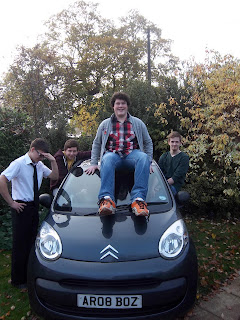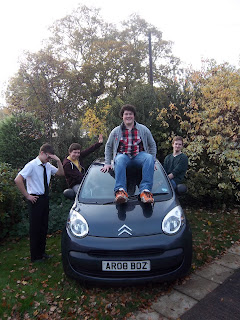Thursday, 13 October 2011
Film Magazine: Editing Process
Film Magazine Construction (Photoshop)
Stage 1
Similar to my film poster, I had to create a canvas for my film magazine in the same format. The structure was the international size Photoshop allows you to use so that there is a sense of continuity in my products.
Stage 2
Soon after that, I created the title and tagline of the magazine with the same fonts as my film poster. Again, this created a sense of continuity.
Stage 3
Whilst creating shapes for my poster, I clicked on the 'Ellipse' tool and changed the colour to yellow. This then allowed me to drag the tool outwards in order to create a yellow circle.
After that, I clicked on the 'Fx' tool in the bottom right and pressed 'Stroke'. By doing this I was able to enable a black outline around my circle for emphasise.
Stage 4
When intergrating the film's title into my magazine cover, I used the similar colour schemes and font my film poster and magazine title still used in oreder to represent my use of continuity. The film titles tagline was the same as the main titles tagline too.
Stage 5
During mid constuction, similarly to my film poster, I realised the fonts I used for my titles where not the one I selected in my font research. Therefore, I changed my film title and magazine title so that it looked more realistic and effective. To do this I highlighted my film magazine title and pressed on the font "Arial Black".
After I pressed "Arial Black", my title appeared a lot more effective. Likewise for my film title too, it's evident they both look more mature.
Stage 6
To merge layers together, I highlighted the two layers I wanted to merge together but pressing the apple sign on the MAC PC and pressing the mouse. After that I went to the "Layer" option at the top and clicked on "Merge Layers".
Stage 7
Whilst inserting sellines, I had to make sure there alinement was accurate and had font that looked effective. Similar to my film magazine and poster, I used the same colour schemes and range font so that the style of my film magaizne appeared appealing and narrow structured.
Stage 8
To crop my image, I pressed on the 'Crop' icon positioned on the left and selected the area of the image I wished to keep.
Finally, to use the crop tool I then pressed on the 'Black Arrow' and pressed 'Crop', which left me with the cropped image.
This is a quick video showing you how I used the 'Magic Tool' and 'Quick Select' effectively to take the characters from the background of the image.
Stage 10
Finally, to add the image to my film magazine, I selected the layer in the image on the right and dragged it across too the film magazine on the left. I then had a 'Layer' with the image inside at my disposal now. Therefore, this led to the completion of my Film Magazine's first draft.
Film Magazine: Photoshoot Conclusions
This particular photo is a good candidate for my film magazine because it conveys the facial expressions I wanted my actors to depict. However, the lighting seems to be too heavy on the left side of the shot and I feel Conor Davies (Right) doesn't look as arrogant as I wanted him to look. Therefore, I am not going to use this shot because of these reasons and also the bottom half of the actors have been cut off so it won't work in comparison to my rationale.
Again, this image is another good choice and similar to the previous shot, it conveys the same positives. However, it also conveys similar negatives such as the lighting problem and lack of lower body. Although Conor Davies (Right) does appear to depict the facial expression I wanted but this image won't work because it doesn't have the lower half of my actors bodies.
Finally, I have fixed problem the occurring from the lack of my actors lower body. Now the image looks similar to my rationale. However, I have decided against this image because Tom Colledge (Left) doesn't convey the facial expression I wanted for the image and also the lighting is still slightly too bright.
This image is good, and Tom Colledge (Left) not depicts the facial expression I wanted. However, Conor Davies (Right) hasn't captured the facial expression I wanted so I have decided to reject this image because of those reasons. So far, Jake (Centre) has shown constant facial expression's excellently and his enclosed stance connotes the insecurity and fear and I wanted is charecter to feel.
PErsonally, I think this is the image I am going to use for my film magazine. This is purely because the light doesn't ruin the photo in comparison too the others. The reason I had that light in the first place is too suggest the sun and connote a summer film. Furthermore, all the actors captured the facial expression I wanted perfectly. Although Tom (Left) and Conor (Right) look small in contrast to Jake (Centre), this is a good thing because it asserts Jakes dominance as a main character.
Film Poster: Construction & Annotations
Film Poster Construction (Photoshop)
Stage 1
Firstly, I opened Photoshop and pressed on 'File' then 'New' in the top left of the screen. Then after pressing 'New', a 'New' tab opened up and allowed me to customise the setting of my film poster's canvas. I decided to press on the 'International Paper' so that my film poster would have the same layout as other film posters my target audience are interested in. The size was A3 and the resolution was 300 so that converting my film poster to A4 would be easy if need be. However, I plan to print it out in A3 so that is of a realistic quality that will entice my target audience.
Stage 2
Next, I had to download my film posters font. So, I downloaded the second font down from the top of the screen because it was the font I planned to use in my font research previously. To do this, I pressed on the 'Download' button on the far left.
After that, 'Font Book' opened and allowed me to install my font. This now allowed me to use my font on Photoshop for my film poster.
Stage 3
In this stage of the production stages I wanted to create a layer that would allow me to edit my text easily and effectively. To do this I had to click on the little icon you can see highlighted in the bottom right of the image. After clicking that it created a new layer.
Stage 4
Editing text was vital because I needed it to create the same effect my rationale created. For instance, to change my colour to red I had to click on the 'Fx' icon you can see highlighted at the bottom right of the image. After clicking on this it gave me a range of effect options for my text. I used "Colour Overlay" to change the text colour to red, then I used "Stroke" to emphasis the letters outline.
Stage 5
To insert an image into my work, I had to click on "File" whilst in Photoshop, then "Open" so that I could open the image I saved from Google images. This opened up the image and allowed me to drag the picture onto my film poster draft.
Stage 6
I suddenly realised that I was using the wrong font for my film title and tagline on my trailer because I began to feel it looked quite childish in Photoshop. Therefore, I changed the font types around on the title and tagline and now I feel the film poster's font relates more to my font research and audience's interests.
Stage 7
On the right you cans see I have opened the image I have chosen to use as a separate document. After that I selected it and dragged onto the 'Film Poster: First Draft' document.
Here you can the see the image has successfully moved across onto my Film Poster document ready to edit.
Stage 8
After a few adjustments of the text I had to increase the size of the image by pressing 'Ctrl + T'. This lead to the completion of my Film Posters first draft.
Film Poster: Photoshoot Conclusions
I like this image because most of the actors have the facial expressions and body expressions I intended. However, Tom Colledge (Mid-Left) doesn't appear of equal size to the others and I wanted him to be seen by the target audience so that my different audience members can relate to each character type. Therefore, I have rejected this image.
Similar to the previous image, I thought this image had potential but I have decided against it because the lighting just looks to dull for comedy film. Therefore, instead of lighting the image on Photoshop, I decided to use the flash of the camera.
Personally, I feel this is the best image taken from the photoshoot because the use of the prop; alcohol really emphasises the relationship this film has with it's similar films such as 'The Inbetweeners' and 'Superbad'. Furthermore, the lighting came out excellently and has exaggerated the colours I used deliberately in order to connote happiness, excitement and fun. Therefore, I have decided to use this image for my Film Poster.
The use of the prop; alcohol was used in this image but I have decided against it because the lighting didn't appear as strong on this image as it did on the previous one. Therefore, I have decided against using this image.
Subscribe to:
Comments (Atom)




























































